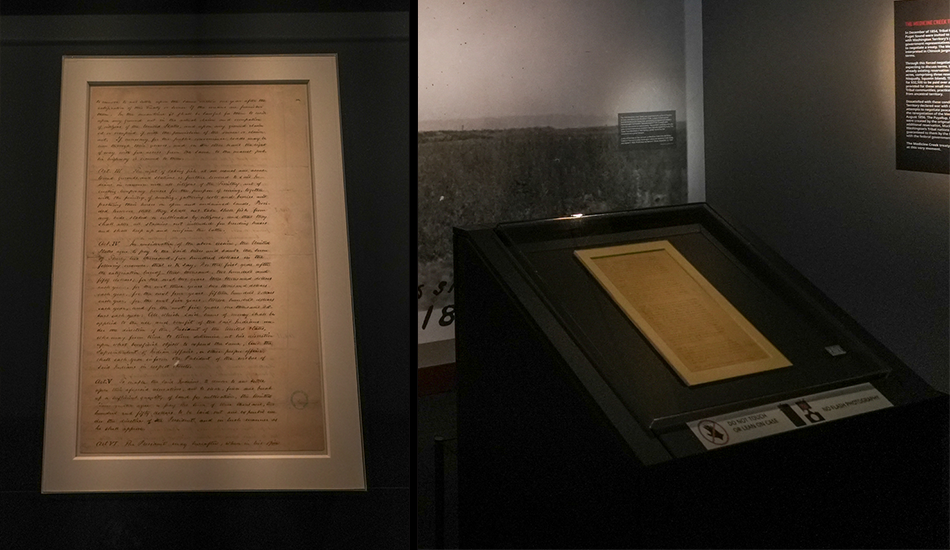By Hailey Palmer, Puyallup Tribal News
From now through July 8, the public can view a page of the original Medicine Creek Treaty at the Washington State History Museum.
The Washington State Historical Society has a page from Article III of the treaty on display at the Washington State History Museum as part of its new exhibit, “The Treaty of Medicine Creek.” The document is on loan from the National Archives and Records Administration.
The Puyallup Tribe signed the treaty along with several other regional Tribes on Dec. 26, 1854, impacting pivotal court cases and land claims more than a century later and shaping life for the Tribe to this day. Puyallup Tribal Council was allowed to preview the exhibit before it officially opened to the public.
“It’s a pretty big investment for us to bring it here in terms of time, building a special case and having the security around it; but to us, it really felt meaningful and important to have it here, in this space at this time,” said Gwen Whiting, lead curator at the Washington State Historical Society.
The treaty stipulated that Puyallup, Nisqually, Steilacoom, Squaxin Island and other treaty Tribes would give up more than 2 million acres of land. In return, they received three small reservations, $32,500 and access to traditional hunting grounds. Historians believe that Tribes were coerced into signing the treaty and that some signatures were forged after multiple Tribal leaders walked away from negotiations. Hostilities between regional Tribes and Gov. Isaac Stevens’ territorial government escalated into the treaty wars of 1855 and 1856.
More than 100 years later, Judge George Hugo Boldt referred to the Medicine Creek Treaty before affirming Tribal fishing rights with his Boldt Decision of 1974.
“The Treaty of Medicine Creek” exhibit is on display until July 8 and is across the hall from another exhibit, titled “Usual and Accustomed Grounds: The Boldt Decision at 50,” which focuses on Native fishing rights and the Fish Wars and will be on display until Sept. 1.
“I think it’s important for our people to come see and experience, not only honoring our ancestors and those that came before us, but repairing the next seven generations,” said Washington State Historical Society Tribal Liaison and Colville Tribal member Pam James. “It’s our responsibility to ensure the next seven generations know who they are. I think that’s what’s most important for our people.”
James said she worked closely with Tribes across Washington state in planning and putting together the exhibit.
“I worked with their cultural departments, Tribal preservation officers, in making sure we’re getting the information correct right from the Tribes,” James said.
Before the exhibit opened to the public on Feb. 10, the Puyallup Tribe’s Heritage Division welcomed the treaty with songs. Heritage Division Manager Connie McCloud also gave a blessing.
“We wanted to make sure that, once it was being installed, the (Puyallup) Tribe came in and welcomed the treaty home,” James said. “We also wanted to make sure we did the song and the blessing to make sure it was taken care of in a good way, spiritually, as well as honoring our ancestors and those who signed it.”
The Washington State History Museum is open Tuesday through Sunday from 10 a.m. to 5 p.m. Adult admission is $14 while seniors, students, and active or retired military admission is $11. Children 5 years old and under are free.





